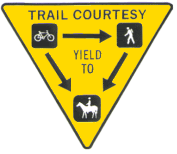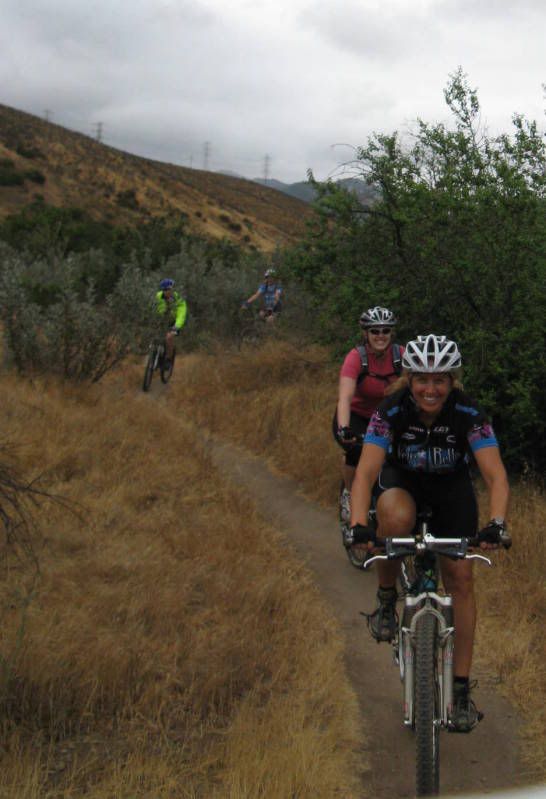Because of the quality of the soil, bike tires leave ruts that destroy the trail. We wanted to ride, but knew we couldn't do so anywhere near the coast that morning. Laurie suggested that we head east to Mission Trails, near where she lives, since it wasn't raining there when she left. So we all caravanned to Mission Trails. Mission Trails is very beginner-friendly, with wide double track as well as flowy singletrack. Before leaving the parking lot, we discussed equestrian right-of-way, and what I call the mountain bike basics, or the beginner's mantra: "Pedals level, weight back, arms relaxed, shoulders square."
 Horses on the trail
Horses on the trail May of the trails in San Diego are multi-use trails, and cyclists often come upon hikers and horses. Because it's important to foster good relations between cyclists and other trail users, no one should ever hesitate to practice good trail etiquette. When coming upon horses from behind, I always call out: "Ride leader! There are four of us mountain bikers. May we pass?"
There is always a ride leader, even if it's an informal ride; someone will answer you. Calling out to the ride leader 1) lets the horse riders know you are coming so you don't surprise them, 2) identifies you as a person, since you do not look like a person to a horse, but a head on top of a bike, and 3) empowers the horse riders and shows them respect.
Slowing down or even dismounting and calling out to a group of horse riders may seem unusual, but it's important to remember that in addition to having the right-of-way, equestrians often have a lot more money and power than the mountain bikers. It's in our best interest to make sure we do all we can to foster good relations and practice good trail etiquette at all times.
Mountain bike instruction
Pedals level: Unlike on a road bike where you can coast with one foot down, you should get into the habit on a mountain bike of coasting with your pedals level. Not only does it keep you from striking obstacles like rocks and roots with your downward-extended pedal, it also facilitates you standing on your pedals, giving you greater control and allowing you to shift your weight as needed.
Weight back: This is mostly a reminder to shift your weight back on descents or when going over obstacles. More accurately, you push the handlebar away from you over obstacles, but weight back is the same idea. If you have your weight back, you have less of a chance of going over the bars.
Arms relaxed: Too many riders find themselves in the middle of a ride employing the "death grip" to the handlebar. You should be able to wiggle your fingers at any moment on the bike. Having a vice-like grip on the handlebar will only impair steering and bike handling. Your front wheel will often find the best path through a rock bed or sand. If you apply a light grip with your weight off the handlebar, you'll be more successful at navigating those tricky sections.
Shoulders square: If you keep your shoulders square to the trail and where you want to go, you'll have an easier time of actually going in the direction you want to go. With your head up, and your shoulders square to the trail, you and your bike are centered and where you need to be.
 We rode for a bit on the doubletrack, then practiced getting our front tire over a stick - the beginnings of jumping with the bike. If you get your front tire over the stick, the rear tire will naturally follow. Those who mastered this early were encouraged to use their clip pedals to lift the rear tire over the stick as they went. The motion mimics that of a rabbit hopping over a log. Once you can pop the front tire up and the back tire up, you put the motions together. We didn't have time to work very long on bunnyhops, but everyone did really well and will be able to practice on her own for next time.
We rode for a bit on the doubletrack, then practiced getting our front tire over a stick - the beginnings of jumping with the bike. If you get your front tire over the stick, the rear tire will naturally follow. Those who mastered this early were encouraged to use their clip pedals to lift the rear tire over the stick as they went. The motion mimics that of a rabbit hopping over a log. Once you can pop the front tire up and the back tire up, you put the motions together. We didn't have time to work very long on bunnyhops, but everyone did really well and will be able to practice on her own for next time. We only practiced two difficult climbs and descents. Most of the coaching involved helping the girls approach a hill in the right pedaling gear, knowing when to shift, knowing when to stand up, and refining the balance required so that you don't spin out before you reach the top. The descending skills involved reading the terrain, remembering to stay relaxed, proper body position on the bike, and the importance of not getting ahead of yourself (keeping your head up).
The response to the ride and the coaching was really positive, and I know everyone was proud of her efforts at the end of the ride. Everyone challenged herself and came away feeling more confident. :)




No comments:
Post a Comment